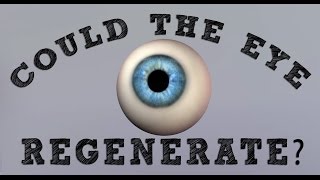Imagine that day by day, your field of vision becomes slightly smaller,
想象一下,每天你的视力范围变小一点,
narrowing or dimming until eventually you go completely blind.
能见的范围越来越窄,或者视线越来越模糊,直到最终你完全失明。
We tend to think of blindness as something you're born with,
我们总是觉得失明是与生俱来的,
but in fact, with many diseases like Retinitis pigmentosa and Usher syndrome,
但实际上很多疾病,比如视网膜色素病变以及乌谢尔综合症,
blindness can start developing when you're a kid, or even when you're an adult.
失明可以从孩童时期甚至是成年时期产生。
Both of these rare genetic diseases affect the retina,
这两种罕见的遗传病都会影响视网膜,
the screen at the back of the eye that detects light and helps us see.
视网膜是位于眼球后部的一个屏幕,能够感光,并帮助我们看见东西。
Now imagine if the eye could regenerate itself so that a blind person could see again.
现在你想象一下,如果眼睛能够有自我修复的能力,那么盲人就能重新看见世界了。
To understand if that's possible,
要明白这到底可不可行,
we need to grasp how the retina works and what it has to do with a multitalented creature named the zebrafish.
我们便要了解视网膜的原理以及它与一个叫做斑马鱼的多才生物有什么关系。
The human retina is made of different layers of cells,
人类的视网膜是由不同层的细胞组成,
with special neurons that live in the back of the eye called rod and cone photoreceptors.
这些特殊的神经细胞分布在眼球的后部,叫做视干细胞和视锥细胞。
Photoreceptors convert the light coming into your eye into signals that the brain uses to generate vision.
这些感光细胞把进入眼睛里的光转化成神经信号,传输给大脑以产生视觉。
People who have Usher syndrome and retinitis pigmentosa experience a steady loss of these photoreceptors
患乌谢尔综合症及视网膜色素病变的人逐渐丧失了这些感光细胞,
until finally that screen in the eye can no longer detect light nor broadcast signals to the brain.
最终这片眼球中的屏幕没法再感受到光,也无法传递神经信号到大脑。
Unlike most of your body's cells, photoreceptors don't divide and multiply.
与大多数的身体细胞不同,感光细胞不能分裂和繁殖。
We're born with all the photoreceptors we'll ever have,
我们出生的时候都带着感光细胞,
which is why babies have such big eyes for their faces and part of why they're so cute.
这也是为什么婴儿的脸小小的,眼睛都那么大、那么可爱。
But that isn't the case for all animals.
但非所有的动物都如此。
Take the zebrafish, a master regenerator.
比如说斑马鱼,有着超级复原能力的一种生物,
It can grow back its skin, bones, heart and retina after they've been damaged.
即使它的皮肤、骨骼、心脏和视网膜受损了,它也有能力让它们重生。
If photoreceptors in the zebrafish retina are removed or killed by toxins,
假如斑马鱼的视网膜感光细胞被毒素移除或者破坏,
they just regenerate and rewire themselves to the brain to restore sight.
它们仍然能够重生并且自我重组,进入大脑来再造视觉。

Scientists have been investigating this superpower
科学家一直在研究这种超能力,
because zebrafish retina are also structured very much like human retina.
因为斑马鱼的视网膜和人类的视网膜结构很相似。
Scientists can even mimic the effects of disorders like Usher syndrome or retinitis pigmentosa on the zebrafish eye.
科学家甚至能够模拟乌谢尔综合症或者视网膜色素病变对斑马鱼眼睛的影响。
This allows them to see how zebrafish go about repairing their retinas
这样,科学家们便能够了解斑马鱼是如何修复自己的视网膜的,
so they might use similar tactics to fix human eyes one day, too.
从而使用相近的手法来修复人类的视网膜。
So what's behind the zebrafish's superpower?
究竟为什么斑马鱼有这种超能力呢?
The main players are sets of long cells that stretch across the retina called Muller glia.
大功臣是一组分布在视网膜的长细胞,它们叫做穆勒细胞。
When the photoreceptors are damaged, these cells transform, taking on a new character.
当感光细胞受损,穆勒细胞便开始转化,赋予自己一个新的角色。
They become less like Muller cells and more like stem cells, which can turn into any kind of cell.
他们不再是穆勒细胞,而更像是干细胞,能够转化成任何一种细胞。
Then these long cells divide, producing extras that will eventually grow into new photoreceptors,
随着这些长细胞的分裂,更多的细胞会渐渐生长,变成新的感光细胞,
travel to the back of the eye and rewire themselves into the brain.
游回到眼珠后部并重组进入大脑。
And now some researchers even think they've found the key to how this works
现在一些研究人员甚至认为他们已经找到这一过程发生的关键,
with the help of one of two chemicals that create activity in the brain called glutamate and aminoadipate.
即依靠两种化学物的帮助来创造大脑活动,这两种化学物叫做谷氨酸和氨基乙二酸。
In mouse eyes, these make the Muller glia divide and transform into photoreceptors,
在老鼠的眼睛里,这两种化学物促使穆勒细胞分裂并转化为感光细胞,
which then travel to the back of the retina, like they're replenishing a failing army with new soldiers.
再游走到视网膜后部,就好像在为一支快垮的军队扩充新的势力。
But remember, none of this has happened in our retinas yet,
但记住,这些都还没发生在人类的视网膜上,
so the question is how do we trigger this transformation of the Muller glia in the human eye?
因此,问题就在于我们如何能够让穆勒细胞的这种转化发生在人类的眼睛里?
How can we fully control this process?
我们如何才能完全支配这一转化过程?
How do photoreceptors rewire themselves into the retina?
感光细胞如何能够进行自我重组进入视网膜?
And is it even possible to trigger this in humans?
对于人类的眼睛来说,这一切都能成为可能吗?
Or has this mechanism been lost over time in evolution?
或是这种机能随着人类的进化已经渐渐消失了?
Until we tease apart the origins of this ability,
除非我们能理清这种能力的起源,
retinal regeneration will remain a mysterious superpower of the common zebrafish.
否则视网膜复原仍将是一个只属于斑马鱼的神秘超能力。











